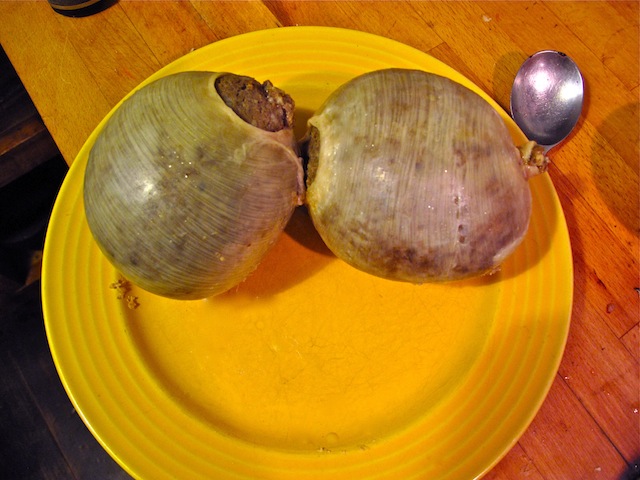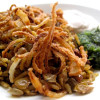Maybe it ought to be oysters or salmon or venison or beef but, when you think of Scottish food, the first thing you think of is the famous Haggis. The great chieftain o’ the puddin’ race has inspired poems, is piped in on the Agony Bags and there are even Haggis hurling contests held throughout the highlands. When it comes to food, you don’t get much more Scottish than that; when you cut the thing open, you half expect it to have its own tartan emblazoned on the inside. Aye, there’s even a Wild Haggis, Haggis Scoticus, displayed at the Kelvingrove Gallery, in Glasgow. It might put the wind up yer kilt, then, to discover that the Haggis might not be a native of Scotland, after all; there is an ongoing argument that this dyed-in-the-heather dish might have come from further afield…
Put simply, Haggis is offal, spices, oats and suet, cooked in a sheep’s stomach. There are variations on the theme, with practically every part of Scotland boasting its own recipe; some are made with beef, some with mutton, some use sweeter spices, where others are more piquant. However, once it’s all wrapped up in the stomach of the preferred animal, there’s no mistaking what it’s supposed to be. There’s even a vegetarian version.
Scottish Folklore
The folklore surrounding the Scottish Haggis suggests that the cattle drovers carried Haggis as rations for the long journeys across the Highlands and into the glens. Other stories tell how, when the local Chieftain or Laird required an animal to be slaughtered for meat, the workmen were allowed to keep the offal and the dish was borne out of a need to make the most out of what they had. However, the most likely explanation is that the Haggis was invented as a way of using up the offal that would otherwise go off, very quickly. The meat, kidneys and liver could be grilled on the spot, but trying to do this with a set of unprepared lungs or looping intestines was a different matter – so, they bagged it all up and boiled it.
Haggis Maximus?
It all sounds so rustic and hands-on, that you’d be forgiven for thinking that the dish simply has to have its roots in Bonnie Scotland. However, the oldest recipe for something Haggis-like comes from none other than Ancient Rome. Apicius was the Roman equivalent of Anthony Worrall-Thompson; a gourmand who loved his food, loved to cook and is the author of the world’s oldest surviving cookery book. His recipe, for Ventrem Porcinum, uses pork, instead of lamb and there’s no mention of the ‘pluck’ (heart and lungs); instead, Apicius recommended using ‘three brains, the nerves removed’, cooked in ‘the paunch of a suckling pig’, alongside a chariot-load of spices, including lovage, ginger and silphium – a now-extinct seasoning, thought to taste a little like asafoetida. But, while this might be the first boil-in-the-bag on record, there are other recipes that are significantly more Haggisey.
Haggis the Horrible?
Clarissa Dickson-Wright, of Two Fat Ladies fame, believes that Haggis was, originally, a Nordic dish, eaten by the Ancient Vikings. She says that the dish “came to Scotland in a longship, even before Scotland was a single nation.” The famous etymologist, Walter William Skeat, backs her theory up, saying that the ‘Hag’ part of the name comes from the Nordic word. ‘hoggva’, meaning to strike or to chop up – a good description of the way that Haggis is made. Most of the recipes uncovered suggest that the Ancient Vikings used lamb, just as the Scottish do, and that they developed the practice for soaking the offal in milk, as part of its preparation – a method that is still employed by Scottish Haggis-makers, today.
As English as Haggis ‘n’ Mash
But there’s a further theory; one that might blow the breeks off the toughest Scotsman. The leading food historian, Catherine Brown, has discovered a reference to the dish, in a cookbook called The English Hus-Wife, by Gervase Markham. Before we go any further, let’s just remember that the poem that put the Scottish stamp on the Haggis, Address to a Haggis, was written by Robert Burns in 1786. The recipe for Haggis in The English Hus-Wife was not only put to parchment 171 years earlier, in 1615, but – and hold onto your sporran – was written in England. Not a tartan in sight. But the recipe’s there: the pluck, the spices, and the sheep’s stomach; it’s Haggis, just without the history.
Burns on the Haggis
Brown’s theory is that, after the Act of Union with England, in 1707, Scottish nationalists appropriated the Haggis as a symbol of their Scottishness: “we’d lost our monarchy, we’d lost our parliament and we gained our Haggis. There was a latching onto everything that was distinctive about Scotland and Burns had identified the dish in such an evocative way.” It seems that Burns is the man responsible for making the Haggis synonymous with the Scottish nation, even though its origins are questionable. However, there are those Scotsmen who simply don’t care where the thing was made: Ian Scott, member of the Saltire Society, which aims to preserve all aspects of the Scottish culture, said “I’d tuck into it with even greater gusto if I thought that it had been invented by the English. I mean, they are bound to have invented something worthwhile.”
Regardless of who thought of it first, the Haggis is as iconic and synonymous with Scotland as whisky and the Loch Ness Monster. James MacSween, owner of Scotland’s award-winning haggis-making company, MacSween’s, says that it may well be that the dish was eaten in England long before it ever crossed the borders, “but Scotland has done a better job of looking after it. I didn’t hear Shakespeare writing a poem about Haggis.”





